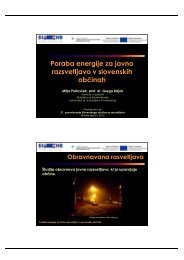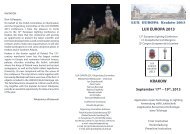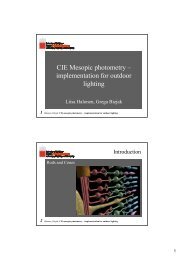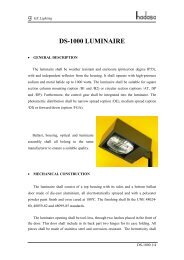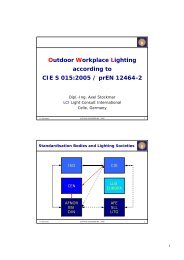Zbornik - SDR
Zbornik - SDR
Zbornik - SDR
Create successful ePaper yourself
Turn your PDF publications into a flip-book with our unique Google optimized e-Paper software.
“ Energy efficiency in INTERIOR Lighting – a Romanian Case Study ” R-3<br />
Photometric measurement: Average illuminance - norm/measured (designed); Illuminance<br />
uniformity - min/av.; Lighting source luminance; Luminance contrast - source/ceiling<br />
Electric measurement: Voltage<br />
Technical state: Lighting source - clean/dirty/painted; Installed power per unit - W/m 2<br />
and/or W/(m 2·100 lx); Switching control – wall mounted/local, manual/automatic control<br />
Maintenance programme: Is there a scheduled activity? Last date of the change of the<br />
lamps/luminaries - Yes / No; Cleaning period of the room/installation - Yes / No<br />
The Quality Value Method. The quality of the lighting installation is influenced by different<br />
parameters. They cover the lighting quality – referred by its photometric parameters -, the lighting<br />
energy-effectiveness – referred by its economic parameters -, and the benefit of final users – referred<br />
by their comfort, pleasantness and productivity. The importance of different parameters varies inside<br />
of each of these groups and also between them. Following the Krochmann study (1990), there are<br />
proposed a method and a model for quantifying them into a final “quality value” number, by<br />
weighting the meaning of parameters and by evaluation of their levels.<br />
The photometric parameters targeted to the lighting quality are: average illuminance, illuminance<br />
uniformity, modelling (cylindrical illuminance), lighting source luminance, luminance distribution<br />
(contrast) on the visual field, reflectance of the room surfaces – walls, ceiling, ground, luminaries<br />
protection angle, correlated colour temperature, colour rendering index and a lot of many others.<br />
Each of the parameters – noted with x – has a certain importance on the quality assembly, noticed by<br />
the weighting factor w(x), valued from 1 (lowest) to 10 (highest importance). Each of the parameters<br />
is evaluated in function with its effective value, compared with the standard, recommended or<br />
optimum value by the scaling factor s(x), valued from 1 to 10. Each of the parameters contribute to<br />
define the quality value of the lighting installation by the quality factor q(x), product of both specific<br />
factors<br />
q(x)=w(x)·s(x).<br />
The effective quality factor of the installation is the sum of the quality factors of each component<br />
parameters q ef =∑ w(x)·s(x), having the minimum - min q ef =∑ w(x) -, and, respectively, the maximum<br />
value - max q ef =10 ∑ w(x).<br />
The optimum quality factor of the installation is corresponding to the standard, recommended or<br />
optimum values, being the maximum value q opt =max q ef =10 ∑ w(x).<br />
The Quality Value, describing the overall quality of the lighting installation, is the ratio:<br />
q<br />
Q =<br />
q<br />
opt<br />
⋅10<br />
=<br />
∑ w(<br />
∑<br />
x)<br />
⋅ s(<br />
x)<br />
ef .<br />
w(<br />
x)<br />
The scaling factor of each parameter x is defined by comparing the effective value, measured or<br />
designed, to the normalised value, recommended or admissible, and introducing the<br />
minimal/maximal values ratio:<br />
( seff<br />
, snorm<br />
)<br />
( s , s )<br />
min<br />
s( x)<br />
= 10 ⋅<br />
.<br />
max<br />
eff<br />
norm<br />
By using the ratio of the two illuminances, we take into account the following aspects: on one<br />
side, an installation which assures an illuminance level lower than the normalised value is under<br />
standard, but the rules concerning the illuminance are, as we all know, very elastic and conjectural<br />
(there are many working installations with illuminance levels well under the normalised values,<br />
accepted by the users); on the other side, an installation which assures an illuminance level higher<br />
than the normalised value does this by consuming extra electrical energy over the right balance. In<br />
“Lighting engineering 2006” stran 17



